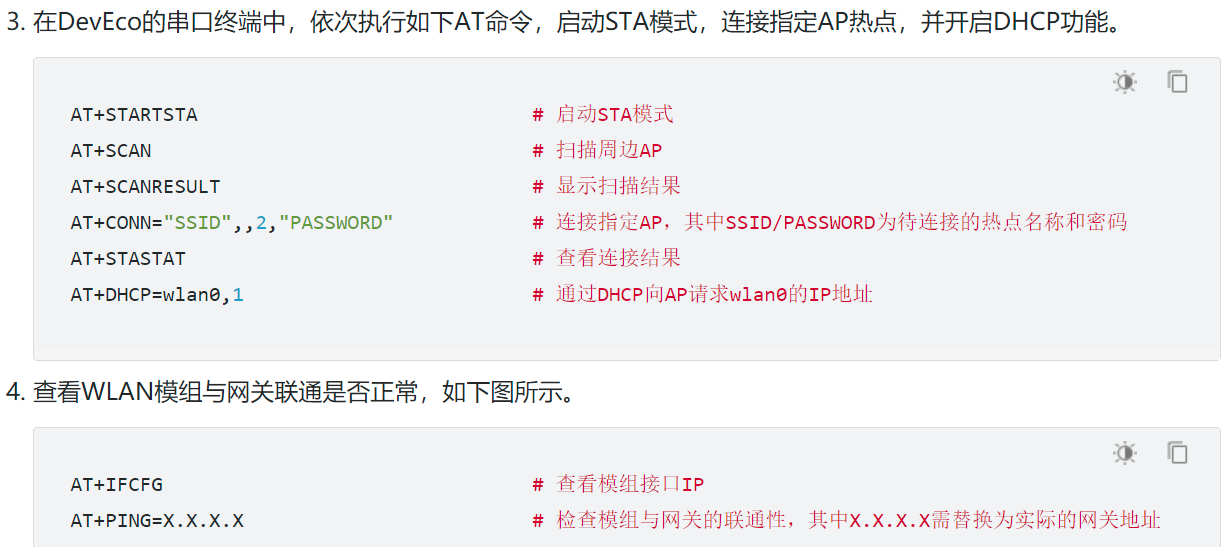这些天在研究软总线组件,因为要连接WiFi进行调试,如果按照官方文档的如下步骤进行操作,肯定不合适:

在社区上找到连志安老师的《Hi3861 WiFi操作,热点连接》以及网友double\_\_整理的《Hi3861 WiFi连接》,参考代码可以运行和连接WiFi,但个人感觉仍稍显复杂/繁杂,于是我自己就研究了一下。
首先,上面官方的步骤,我们可以简化为:
step 1: AT+STARTSTA # 启动STA模式
step 2: AT+CONN="SSID", ,2,"PASSWORD" # 连接指定AP,其中SSID/PASSWORD为待连接的热点名称和密码
step 3: AT+DHCP=wlan0,1 # 通过DHCP向AP请求wlan0的IP地址
中间的其他步骤,完全可以省略。
我们到 at 模块去看一下:
hi_void app_main(hi_void)
{
#if defined(CONFIG_AT_COMMAND) || defined(CONFIG_FACTORY_TEST_MODE) //AT指令模块的初始化。如果初始化成功,则开始注册各类AT指令。
ret = hi_at_init(); // @//vendor/hisi/hi3861/hi3861/components/at/src/hi_at.c
if (ret == HI_ERR_SUCCESS) {
hi_at_sys_cmd_register(); // 同上 hi_at.c
}
#endif
}hi_void hi_at_sys_cmd_register(hi_void)
{
//vendor/hisi/hi3861/hi3861/components/at/src/at_general.c
hi_at_general_cmd_register();
#ifndef CONFIG_FACTORY_TEST_MODE
//vendor/hisi/hi3861/hi3861/components/at/src/at_wifi.c
hi_at_sta_cmd_register();
hi_at_softap_cmd_register(); //同上 at_wifi.c
#endif
//vendor/hisi/hi3861/hi3861/components/at/src/at_hipriv.c
hi_at_hipriv_cmd_register();
#ifndef CONFIG_FACTORY_TEST_MODE
#ifdef LOSCFG_APP_MESH
hi_at_mesh_cmd_register(); //同上 at_wifi.c
#endif
//vendor/hisi/hi3861/hi3861/components/at/src/at_lowpower.c
hi_at_lowpower_cmd_register();
#endif
hi_at_general_factory_test_cmd_register(); //同上 at_general.c
hi_at_sta_factory_test_cmd_register(); //同上 at_wifi.c
hi_at_hipriv_factory_test_cmd_register(); //同上 at_hipriv.c
//vendor/hisi/hi3861/hi3861/components/at/src/at_io.c
hi_at_io_cmd_register();
}
hi\_at\_sys\_cmd\_register() 注册了Hi3861工程所支持的所有 AT 指令,详情请各位可以自己去查阅代码,我们只看上面三条指令:
step 1: AT+STARTSTA:位于 at\_wifi.c,调用 hi\_wifi\_sta\_start(ifname, &len) 实现功能
{"+STARTSTA", 9, HI\_NULL, HI\_NULL, (at\_call\_back\_func)cmd\_sta\_start\_adv, (at\_call\_back\_func)cmd\_sta\_start}
step 2: AT+CONN="SSID", ,2,"PASSWORD" 位于 at\_wifi.c ,调用 hi\_wifi\_sta\_connect(&assoc\_req) 实现功能
{"+CONN", 5, HI\_NULL, HI\_NULL, (at\_call\_back\_func)cmd\_sta\_connect, HI\_NULL}
step 3: AT+DHCP=wlan0,1 位于 at\_general.c,调用 netifapi\_netif\_find(argv[0]) 和 netifapi\_dhcp\_start(netif\_p) 实现功能
{"+DHCP", 5, HI\_NULL, HI\_NULL, (at\_call\_back\_func)at\_setup\_dhcp, HI\_NULL}
把上面三步封装到 API: WifiLink(),实现如下:
#include "hi_wifi_api.h"
#include "lwip/netifapi.h"
void WifiLink(void)
{
static BOOL fgWifiConnected = FALSE;
if(fgWifiConnected) //防止重复连接WiFi
return;
printf("[WifiLink] Begin: fgWifiConnected[F]\n");
//step 1: AT+STARTSTA
// #启动STA模式
char ifname[WIFI_IFNAME_MAX_SIZE] = {0}; //“wlan0”
int len = WIFI_IFNAME_MAX_SIZE;
if (HISI_OK != hi_wifi_sta_start(ifname, &len))
{
printf("[WifiLink] hi_wifi_sta_start fail\n");
return;
}
//step 2: AT+CONN="SSID", ,2,"PASSWORD"
//# 连接指定AP,其中SSID/PASSWORD为待连接的热点名称和密码
hi_wifi_assoc_request request = {0};
request.auth = HI_WIFI_SECURITY_WPA2PSK; //2
char* ssid = "SSID"; //Your SSID, HI_WIFI_MAX_SSID_LEN 32 Byte
char* pswd = "PASSWORD"; //Your PSWD, HI_WIFI_MAX_KEY_LEN 64 Byte
memcpy(request.ssid, ssid, strlen(ssid));
memcpy(request.key, pswd, strlen(pswd));
if (HISI_OK != hi_wifi_sta_connect(&request))
{
printf("[wifilink] hi_wifi_sta_connect fail\n");
return;
}
//step 3: AT+DHCP=wlan0,1
//# 通过DHCP向AP请求wlan0的IP地址
struct netif* p_netif = netifapi_netif_find(ifname);
if(NULL == p_netif)
{
printf("[WifiLink] netifapi_netif_find fail\n");
return;
}
#if 1 //DHCP 自动分配IP
if(HISI_OK != netifapi_dhcp_start(p_netif))
{
printf("[WifiLink] netifapi_dhcp_start fail\n");
return;
}
#else //设置固定 IP
ip4_addr_t gw;
ip4_addr_t ipaddr;
ip4_addr_t netmask;
IP4_ADDR(&gw, 192, 168, 1, 1);
IP4_ADDR(&ipaddr, 192, 168, 1, 200); //固定到这个 IP
IP4_ADDR(&netmask, 255, 255, 255, 0);
if (HISI_OK != netifapi_netif_set_addr(p_netif, &ipaddr, &netmask, &gw))
{
printf("[WifiLink] netifapi_netif_set_addr fail\n");
return;
}
if (HISI_OK != hi_wifi_start_connect())
{
printf("[WifiLink] hi_wifi_start_connect fail\n");
return;
}
#endif
fgWifiConnected = TRUE;
printf("[WifiLink] End. fgWifiConnected[T]\n");
return;
}注意在 BUILD.gn 的include\_dirs要添加:
"//vendor/hisi/hi3861/hi3861/include",
"//vendor/hisi/hi3861/hi3861/third\_party/lwip\_sack/include",
上面这个函数你可以把它做成 SYS\_RUN(WifiLink), 也可以放到你的代码中合适的地方去调用,就可以实现WiFi的自动连接了。
我本地log:
[WifiLink] Begin: fgWifiConnected[F]
[WifiLink] End. fgWifiConnected[T]
+NOTICE:SCANFINISH
+NOTICE:CONNECTED
然后可以通过AT+STASTAT、AT+IFCFG、AT+PING=www.baidu.com等指令去确认连接状态,完全OK。
作者:liangkz
想了解更多内容,请访问51CTO和华为合作共建的鸿蒙社区:https://harmonyos.51cto.com



